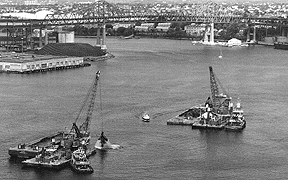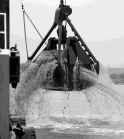
|
Archives:
Fall 2000/Winter 2001 Table
of Contents
Bustling harbors are integral to the commerce of cities throughout the world. And dredging is essential for keeping harbors navigable to increasingly large ships. However, removing sediments is a tricky business, because harbors bear the legacy of past industrial and domestic disposal practices that haven't always measured up to today's standards. Thus, while Boston Harbor has cleaned up its act remarkably since the early 1980s, its sediments still contain organic contaminants such as polycyclic aromatic hydrocarbons (PAHs), as well as heavy metals. When the U.S. Army Corps of Engineers and the Massachusetts Port Authority went about dredging the harbor, they also faced the challenge of disposing of those contaminated sediments. The option chosen for the Boston Harbor Navigation Improvement Project was one deemed to be cost-effective and environmentally sound: digging pits for the contaminated sediments and capping them with clean sand. Specifically, the project involved what are known as confined aquatic disposal (CAD) cells, whereby in-channel pits were dug 40 to 60 feet below the seafloor, filled with dredged contaminated sediments, and capped with three feet of clean sand from the Cape Cod Canal. To minimize disturbance of the contaminated sediments, workers used an environmental dredge–a bucket that makes a cleaner cut and is more water-tight than a conventional clam shell dredge. Along with promising deeper channels for ships, the dredging also offered researchers the chance to study the effects of CAD cells, says Eric Adams, senior research engineer and lecturer in MIT's Department of Civil and Environmental Engineering (CEE). In a six-year, multi-disciplinary project funded by MIT Sea Grant, Adams teamed up with MIT Sea Grant coastal resources manager Judy Pederson and other researchers from MIT, the University of Massachusetts-Boston and The Harvard School of Public Health (HSPH) to examine the physical, chemical, biological, and policy aspects of using CAD cells. The work began four years ago and project scientists hope to provide a strong scientific basis for assessing the technical and environmental risks of capping in relation to other methods of disposing or isolating such sediments. In one effort graduate student Sanjay Pahuja is working with principal research associate Jack Germaine and professor Ole Madsen of MIT's Dept. of CEE, experimenting with MIT's automated fall cone device to determine the effect of initial water content and sediment depth on the rate of consolidation within CAD cells. Their work should help managers determine how long to wait before the cells are strong enough to cap. Recent graduate Chunhua Liu, now with Parsons Engineering Science, worked with Tim Ford of HSPH studying the effects of submarine groundwater discharge on a cap's ability to isolate toxic metals contained in the underlying sediments. And former student Dave Shull, now with the University of Maine, worked with Gene Gallagher of UMass-Boston to evaluate mixing caused by benthic organisms and the role this plays in establishing minimum cap thickness. Of course, CAD cells are just one alternative. Others include not dredging a harbor at all; capping sediments in situ with clean sediments; disposing of them at upland sites; using them to create wetlands; and treating them with technologies that isolate or destroy contaminants. Pederson and Adams recently organized a symposium and workshops at MIT titled "Dredged Materials Management: Options and Environmental Considerations." The conference, sponsored by MIT Sea Grant and several other Sea Grant Programs, drew some 200 scientists and engineers, who explored scientific and technical issues related to nearshore disposal choices, financial and legal issues, and policy implications. Concurrent one-day workshops focused on the use of CAD cells to manage contaminated sediments in ports and harbors; sediment toxicity and risk assessment tools; and the use of dredged materials for erosion control and wetlands creation. Pederson and Adams also served on a Technical Advisory Committee organized by Massachusetts Coastal Zone Management to oversee Boston's dredging activities. They note that the CAD cell technology used in Boston Harbor is relatively new and, as a result, "Boston is being watched carefully as a prototype for other locations, including nearby Gloucester, Salem, New Bedford and Fall River." Those cities may also discover what Adams points out to be a larger issue in dredging a harbor: the intended scope and aim of the project. For instance, the Boston Harbor project was never intended as environmental remediation, but simply as a way to deepen the harbor. As a result, less than half of the contaminated sediments were actually moved and capped. "In a way it's like dusting half of your bedroom floor, or raking half of your leaves. It really isn't as helpful as it could be because the wind is going to redistribute the remaining leaves," explains Adams.
Perhaps the most important finding, says Pederson, has been that dredged materials require longer to consolidate than had been anticipated. This raises "new questions about environmental impacts from open pits without caps," she states. And, she notes, "this initiated an investigation into what are the major causes of resuspension of sediments in the harbor, with the finding that boat traffic causes much of the resuspension." As to the overall success of the disposal and capping process, Adams says: "It’s been reasonably successful, and that success has improved with experience. The project contractors have taken cores and made other indirect measurements (e.g., using acoustic sub-bottom reflection) to make sure the sediments are capped and that the capping material is reasonably intact." However, testing whether or not the project has actually improved the environment is a lot harder. One way researchers have been testing this is by taking measurements of contaminant concentrations in the sediments, and by observing how benthic organisms re-colonize thesediments. And as deeper ships make their way into Boston Harbor, Adams, Pederson and their colleagues will be continuing their work, gathering scientific data to help coastal managers and policy makers best deal with contaminated sediments in their ports and harbors. |

